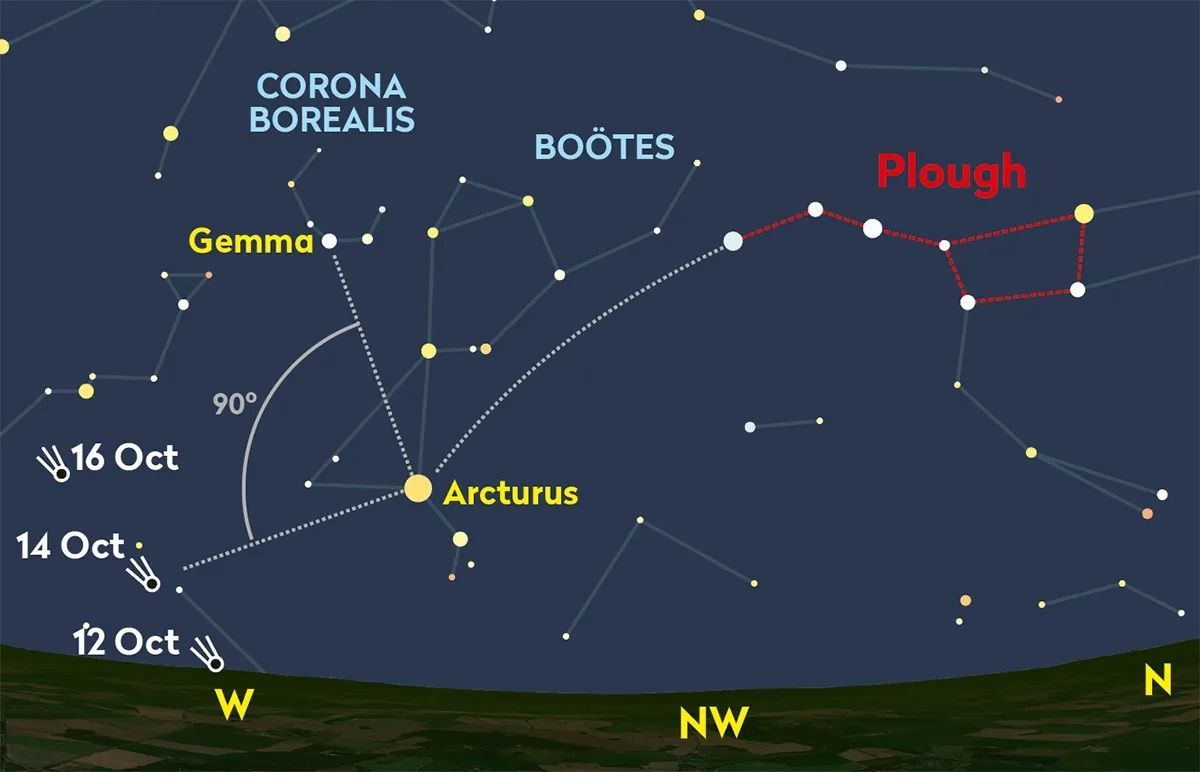80,000 years ago, there was no such thing as a musical instrument, and humans were finding their way out of Africa. Something else happened at that time that hasn’t happened since—until now. Let me introduce you to comet C/2023 A3 (also known as Tsuchinshan-ATLAS), which last passed Earth 800 centuries ago.
What Is C/2023 A3 (Tsuchinshan-ATLAS)?
To explain what this comet is, it’s best to break down its names. Let’s first look at its International Astronomical Union (IAU) code name, C/2023 A3. The “C” signifies that it is officially recognized as a comet, which, according to NASA, is a “frozen leftover from the formation of the solar system composed of dust, rock, and ices.”
“2023” indicates the year it was first discovered, while “A3” means that it was the third comet to be discovered in the first half of January of that year (“B” would represent the second half of January, “C” represents the first half of February, and so on).
Comets are also named after their discoverers (up to a maximum of three in one name), which explains why C/2023 A3 is also called “Tsuchinshan-ATLAS.” It was first seen at the Tsuchinshan Chinese Observatory before being officially confirmed shortly after by the Asteroid Terrestrial-impact Last Alert System (ATLAS).
C/2023 A3 is likely to have originated from the Oort Cloud, given its 80,000-year orbit length, velocity, and orbit angle. Scientists believe that the Oort Cloud—purely a theoretical concept that has never actually been observed—formed when the gravity of the newly formed planets of our Solar System dragged icy objects away from the Sun.
The icy comet in question then eventually settled into its 80,000-year orbit around the Sun. As it moves past the Sun on its way to Earth, it warms up and thaws out, releasing clouds of gas and dust from its trapped, frozen state. Since it passed relatively close to the Sun, C/2023 A3’s misty cloud is so big that it reflects lots of the Sun’s light, which is why we’re likely to be able to see it.
What’s more, its close solar pass means that it has developed two tails—”a curved one made out of dust, and another straighter one made of gas.” The curvy tail follows directly behind the comet’s track, while the straight tail projects away from the comet as the gas is blown away from the Sun.
How to See C/2023 A3
Having made it through perihelion on September 27, when it passed within 58.6 million kilometers of the Sun (for perspective, Earth is 149.3 million kilometers from the Sun), C/2023 A3 will have its nearest flyby to Earth during the second weekend of October (12/13).
The first thing to know is exactly what you’re looking out for. If you’re expecting a bright shooting star-type streak of light, you couldn’t be more mistaken. In fact, according to BBC’s Sky at Night magazine, C/2023 A3 will either look like “a short section of an airplane contrail in the sky, perhaps as long as your index finger, or a little longer, or it will look like a misty shuttlecock, grayish-white in color.” It won’t have a star-like head, and its tails won’t span the whole sky. It’s more likely to take a while to move across the sky, meaning you’ll notice small movements compared to its position the previous evening.
If you’re in the Southern Hemisphere, you might have seen the comet from the end of September to the start of October. Northern Hemisphere sky watchers, however, still have the spectacle to look forward to, with the comet likely to be best viewed just above the horizon to the west on the evening of October 12, shortly after sunset. First, use an astronomy observing app, such as SkySafari, to locate Arcturus. The comet will be visible beneath and to the west of this star.
It will remain visible each evening for a couple of weeks thereafter, becoming fainter as it rises in the sky and moves away from Earth, and it’ll have disappeared from naked-eye viewers by Halloween. It’s also worth noting that the moon will become brighter towards the middle of the month, reaching its full phase on October 17, so the sky won’t be as dark.
All being well, astronomers believe C/2023 A3 will be visible to the naked eye, especially around October 12. However, a pair of binoculars will really let you appreciate its brightness and observe its tails. If you have lots of light pollution in your area, head somewhere darker. I use a light pollution map to help me with this.
How to Photograph C/2023 A3
Going back to my earlier point about dark skies, the same applies to astrophotography. If you’re near any artificial lights, they will flood your camera lens and severely disrupt your shot. Even though the moon will be in its first-quarter phase, try to block off any direct light it emits.
Given its anticipated brightness, you should be able to photograph C/2023 A3 using your smartphone. For the best shots, however, you’ll need a sturdy tripod so that you can set your phone’s camera to a long exposure and keep it very still. If your phone has a night shooting mode, select it, and make sure you adjust the focus so that the brightest stars in the target zone appear clear. Remember to turn down the brightness on your phone’s screen—otherwise, your eyes will take time to adjust when you look back up to the sky.
If you want to capture the comet with its tails, you’ll have the best chance with a wide to mid-angle DSLR camera (or similar). Just make sure you’re constantly adjusting your settings to account for twilight and limit your exposure to a few seconds to make sure that the remnants of the sunlight don’t cloud your shot. The best photographs also include bits of the foreground at the bottom for context, so don’t zoom in too close to the sky.
C/2023 A3 will remain at a low altitude, so you need to set up in a place where trees and buildings won’t block your westerly view. Finally, when sharing your images on social media, be sure to include the device and setup details so that others can take inspiration and grab their own shots!

How to Take Photos of Space With Your Phone
Use your phone to capture The Final Frontier.





